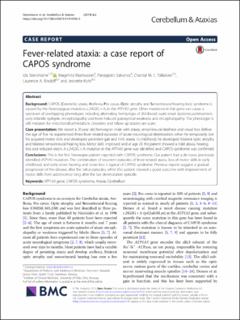Fever-related ataxia: a case report of CAPOS syndrome
Stenshorne, Ida; Rasmussen, Magnhild; Salvanos, Panagiotis; Tallaksen, Chantal; Bindoff, Laurence; Koht, Jeanette
Journal article, Peer reviewed
Published version

Åpne
Permanent lenke
https://hdl.handle.net/11250/2727242Utgivelsesdato
2019Metadata
Vis full innførselSamlinger
- Department of Clinical Medicine [2043]
- Registrations from Cristin [9487]
Originalversjon
10.1186/s40673-019-0096-3Sammendrag
Background:
CAPOS (Cerebellar ataxia, Areflexia, Pes cavus, Optic atrophy and Sensorineural hearing loss) syndrome is caused by the heterozygous mutation, c.2452G > A, in the ATP1A3 gene. Other mutations in this gene can cause a spectrum of overlapping phenotypes including alternating hemiplegia of childhood, rapid onset dystonia parkinsonism, early infantile epileptic encephalopathy and fever induced paroxysmal weakness and encephalopathy. The phenotype is still mistaken for mitochondrial/metabolic disorders and follow up studies are scare.
Case presentation:
We report a 20 year old Norwegian male with ataxia, sensorineural deafness and visual loss. Before the age of five he experienced three fever related episodes of acute neurological deterioration when he temporarily lost his acquired motor skills and developed persistent gait and limb ataxia. In childhood, he developed bilateral optic atrophy and bilateral sensorineural hearing loss. Motor skills improved and at age 20 the patient showed a mild ataxia, hearing loss and reduced vision. A c.2452G > A mutation in the ATP1A3 gene was identified and CAPOS syndrome was confirmed.
Conclusions:
This is the first Norwegian patient reported with CAPOS syndrome. Our patient had a de novo, previously identified ATP1A3 mutation. The combination of recurrent episodes of fever related ataxia, loss of motor skills in early childhood, and early onset hearing and vision loss is typical of CAPOS syndrome. Previous reports suggest a gradual progression of the disease after the initial episodes, while this patient showed a good outcome with improvement of motor skills from adolescence long after the last deterioration episode.
